In for review is the Minisopuru DS808. This is a 13-in-1 docking station, featuring a multitude of display and connectivity options. It is priced at ₱10,700.00 PHP directly from Minisopuru’s online store and $179.89 USD at Amazon.
Specifications wise, the DS808 rocks four display ports, seven USB ports, one LAN port and a single audio port. It is powered by an external adapter and comes with support for PD charging as well. This docking station also supports both Mac and PCs via its USB 3.2 Type-C interface.
Disclosure: Minisopuru sent the DS808 for the purpose of this review. The company did not ask me to say anything particular about it.
Technical Specifications
| Docking Station | |
|---|---|
| Compatibility | Mac, PC (USB Type-C) |
| Material | Aluminum |
| Controller | N/A |
| Connectivity | |
| Display | 2x DisplayPort, 2x HDMI |
| Storage | N/A |
| USB | 4x Type-A, 3x Type-C |
| Network | RJ45 (1000 Mbps) |
| Audio | 3.5 mm (Combo) |
| Dimensions | |
| Length | 168 mm |
| Width | 80 mm |
| Height | 26 mm |
| Weight | 367.5 g |
Packaging and Accessories
The Minisopuru DS808 comes in a multi-part packaging. Surprisingly hefty for its size.
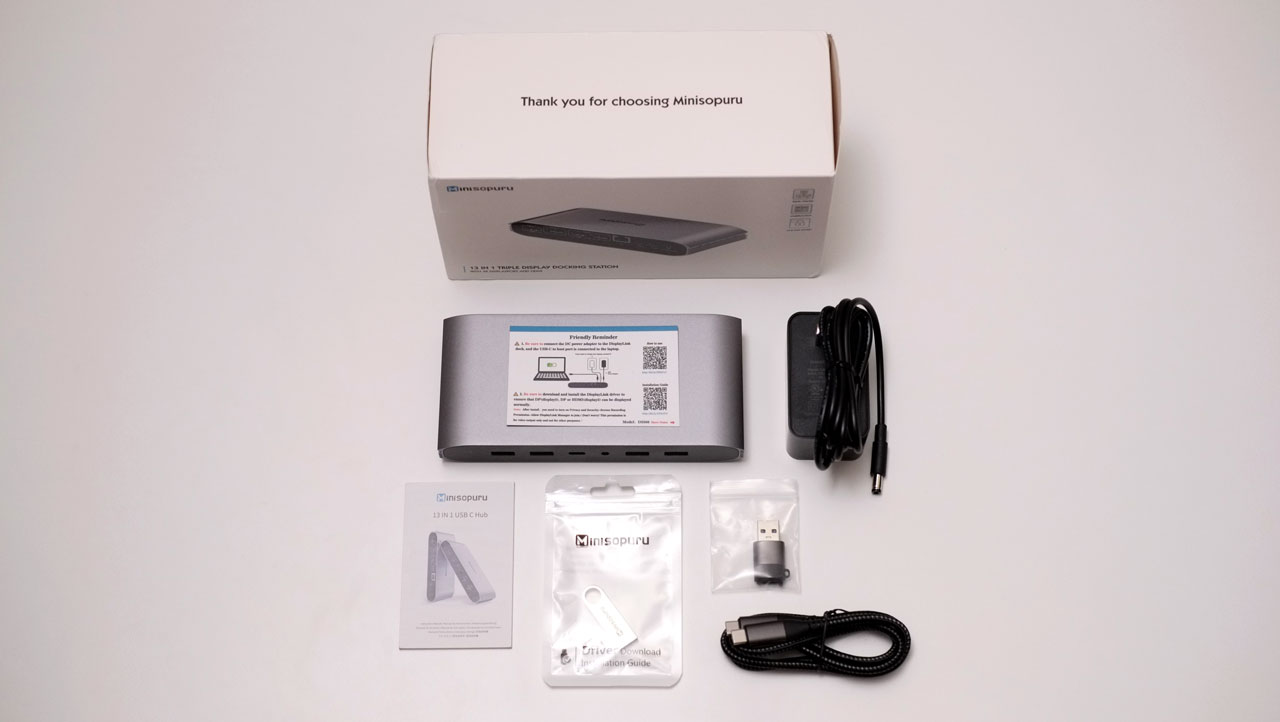
Scope of delivery are as follows:
- Minisopuru DS808
- Power adapter
- USB cable (Type-C to Type-C)
- Flash drive
- USB Type-C to Type-A adapter
- Documentation(s)
The number of accessories included are excellent. Minisopuru even added a flash drive containing drivers and a tutorial on how to setup the dock.
Design, Build and Connectivity
The DS808 sports a design revolving around its extruded aluminum shell. It is powder-coated in gun-metal gray which is a safe color to go with especially for a Mac compatible device.
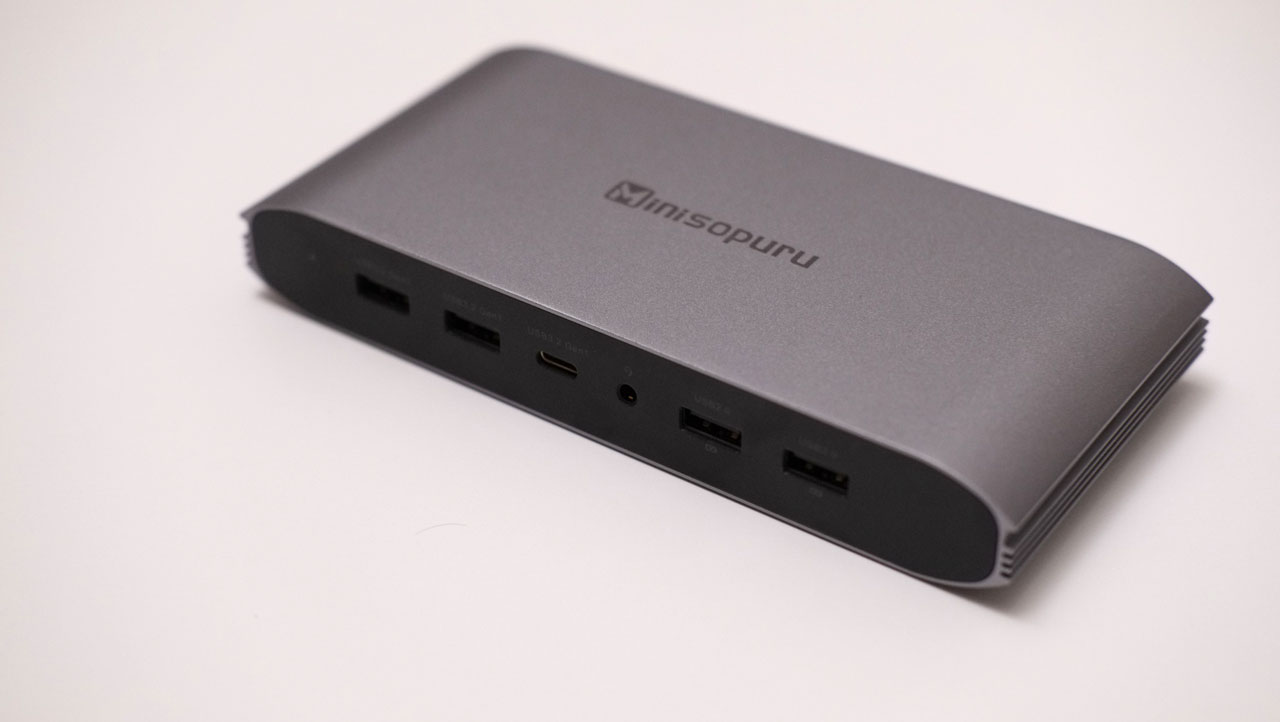
Up front are three USB 3.2 Gen 1 ports (2x Type-A and Type-C), a combo audio port (3.5 mm) and two USB 2.0 ports (Type-A). The USB 2.0 ports could output 7.5 W of power each so they are decent options for charging.
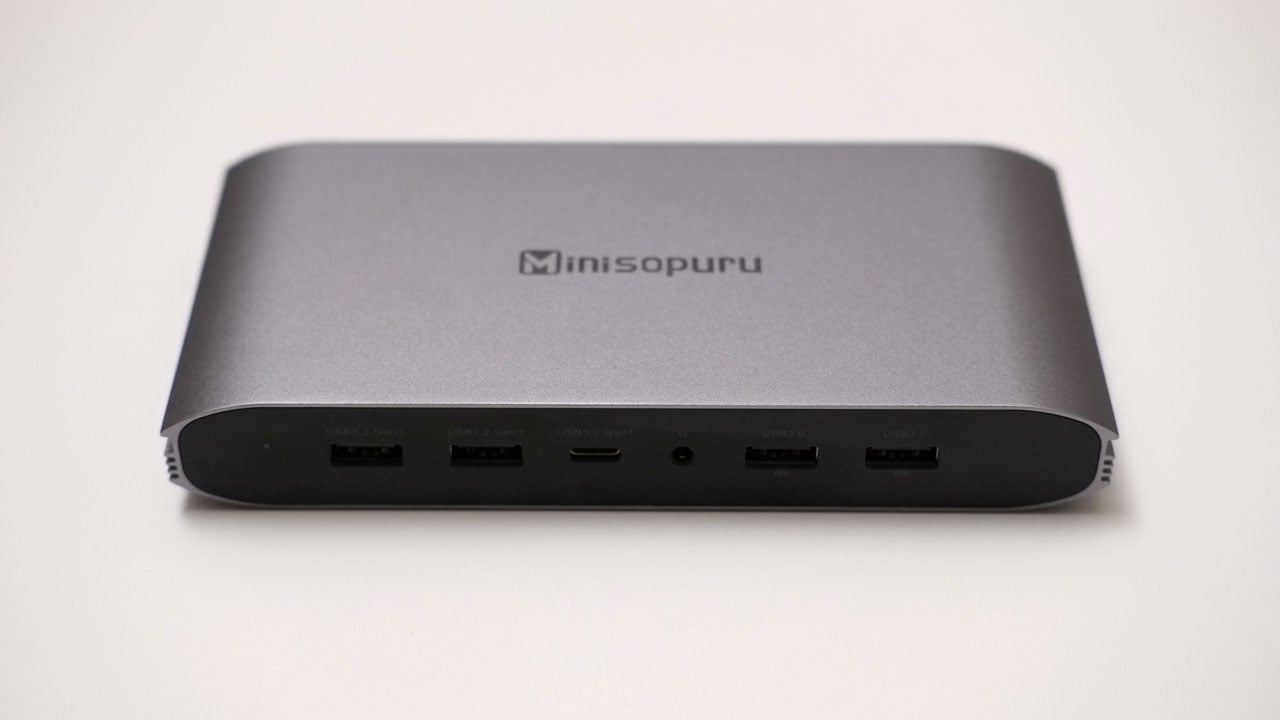
The rear houses the display options. We have four here but you could only connect to a maximum of three combined. We also have a Gigabit LAN port here and a PD port for your charger so you could charge what’s hooked to the host port (both are USB Type-C). Finally we have the DC power port for the independent 36 W power adapter.
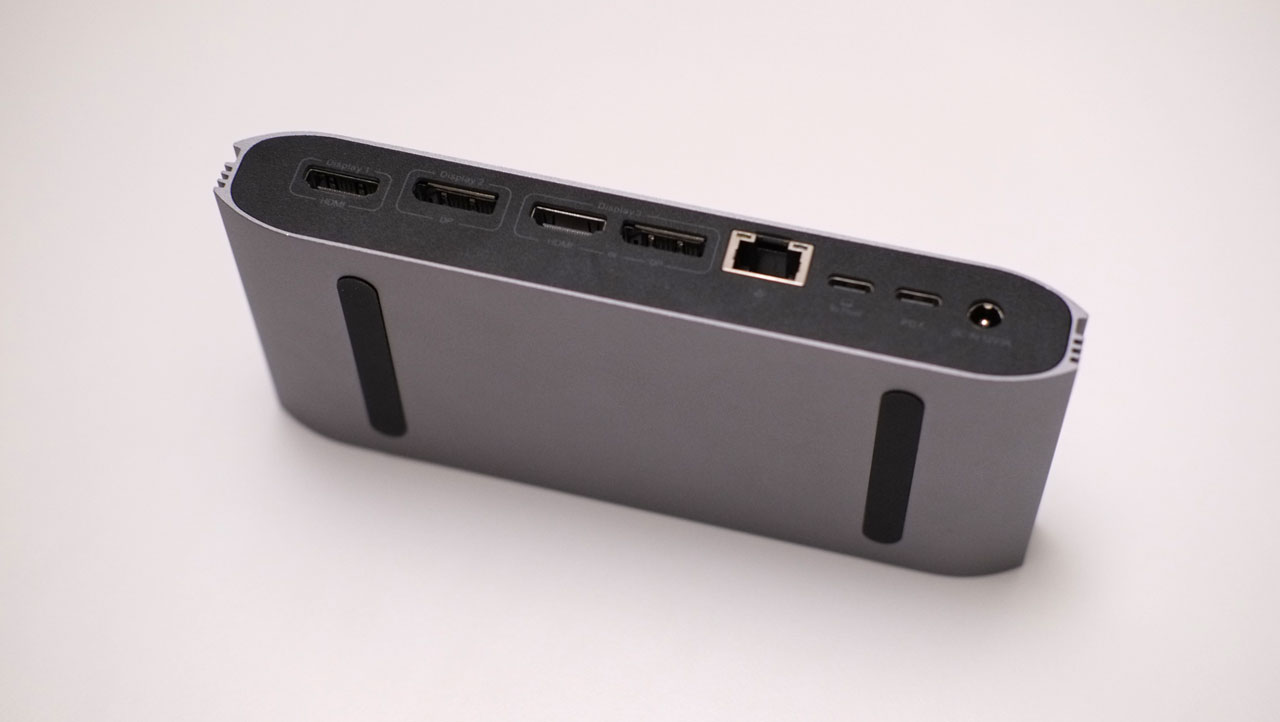
The 36 W power adapter should be adequate or rather more than enough to power the docking station on its own. Note that to power up or charge your device via the host port, you still have to plug a capable PD charger via the PD port.
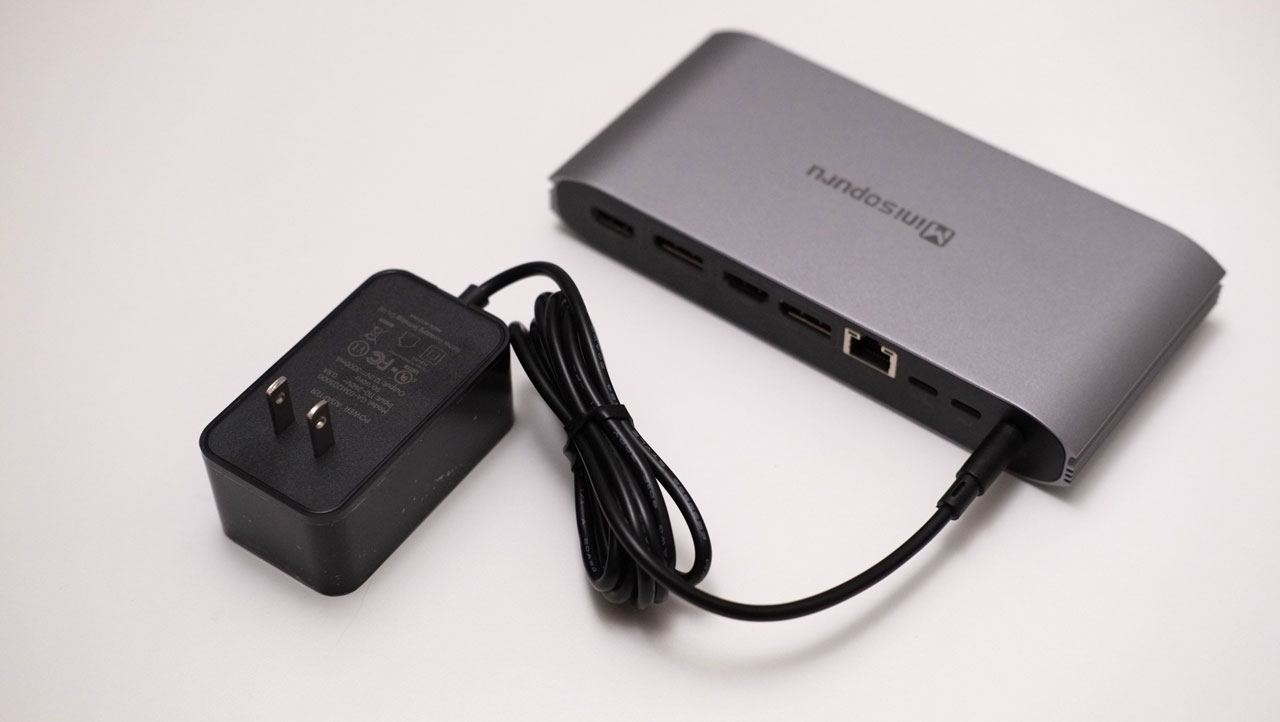
The Minisopuru DS808 appears to be a well-made product packed with features. However, they decided to go with a safer and a cost effective approach with power handling. Had they gone with a more powerful adapter to manage both PD charging and docking station in one solution, then this might be an almost perfect solution for my needs.
Input Lag
Like many docking stations, the DS808 introduced an extra amount latency. I have tested it with the Dell P2723QE which is on its own has an average On Display Lag of 14 ms. That said, the DS808 added at least 2.5x of latency on average based on our measurements.
Storage
Read and write performance results are appropriate for the speeds offered by the DS808. I have nothing negative to say here but I wish we got at least one USB 3.2 Gen 2 interface to test so we could take advantage of some recently released high-speed storage options.
Audio
Now audio out performance is decent enough – even able to power my Sennheiser HD600 with enough headroom. Audio input is a different story though as it comes with a usable yet underwhelming performance. You do not want to adjust the input level to the highest with the DS808 as it will introduce noise and distortion on top of its problematic frequency response.
| RightMark Audio Analyzer | Audio | ||
|---|---|---|
| Interface | In | Out |
| Frequency Response ( dBA) | +14.12, -35.38 | +0.24, -0.65 |
| Noise Level (dBA) | -70.0 | -82.3 |
| Dynamic Range (dBA) | 69.6 | 72.3 |
| THD (%) | 50.515 | 0.06 |
| THD + Noise (dBA) | -3.9 | -53.2 |
| IMD + Noise (%) | 12.223 | 0.084 |
| Stereo crosstalk (dB) | -5.3 | -2.5 |
| IMD at 10 kHz (%) | 94.284 | 0.07 |
Network
Expect lower write or upload performance over the standard full-duplex output of your standard Gigabit NIC.
Power
Power output for the USB ports are good enough in my opinion. Yes, this is clearly not 100 W capable but 84.43 W is not bad at all. For reference, I have tested it with a 140 W PD charger using a 150 W load tester.
Final Thoughts
The DS808 docking station presents a mixed bag of performance across its various array of interfaces. For an instance, the display introduces additional latency, particularly notable with a 2.5x increase on average. The USB performance on the other hand is generally satisfactory, though I still desire for a USB 3.2 Gen 2 interface is to align with contemporary standards and its price point.
Audio output demonstrates decent performance, successfully driving headphones such as the Sennheiser HD600, but the same cannot be said for its audio input. It is characterized by a problematic frequency response, high levels of noise, and distortion.
In terms of its network performance, anticipate lower transmit speeds compared to the standard Gigabit NICs. This is not a bad trade-off but still noteworthy in my opinion.
Regarding power output, the docking station falls short of its 100 W capability but still managed a respectable 84.43 W output, from which I deemed satisfactory.
In closing, it’s important to be aware of the potential trade-offs when considering the DS808 for your docking needs. It is far from perfect so weigh everything according to your needs.
Minisopuru DS808 13-in-1 Docking Station $179.89 USD

Product Name: Minisopuru DS808 13-in-1 Docking Station
Product Description: Triple Display Docking Station for MacBook M1/M2/Windows: Laptop DisplayLink Docking Station with 2 HDMI and 2 DisplayPort,100 W Charge, USB-C Data, Ethernet, Audio, 4 USB Type-A Ports.
Summary
In summary, the DS808 is not without its flaws, and potential users should carefully consider its trade-offs based on their specific needs. It may not be a perfect solution, but its performance in various aspects could still meet the requirements of users with certain priorities and expectations.